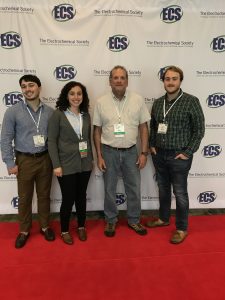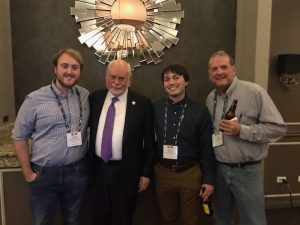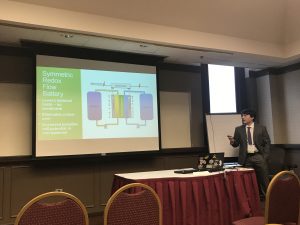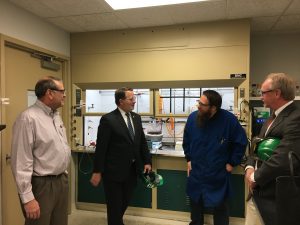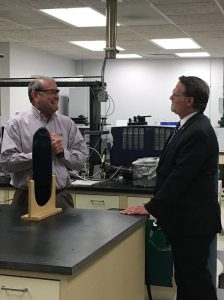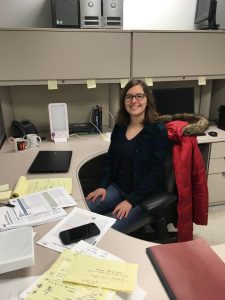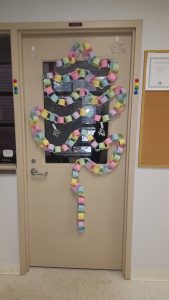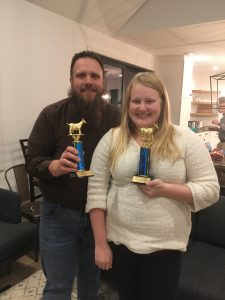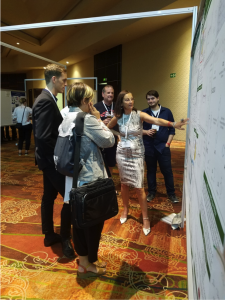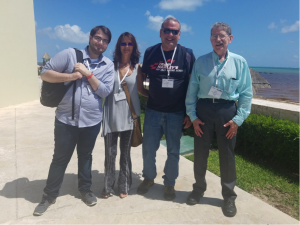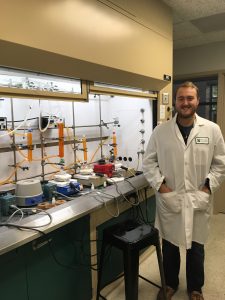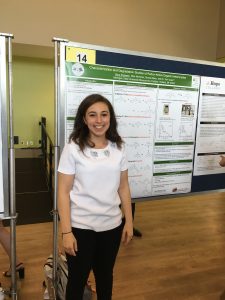Tom Guarr, Anthony Porath and Andrew Rajewski traveled to Dallas to present two posters at the Electrochemical Society conference. They ran into a former intern, Nora Shaheen, who is currently completing her PhD at Case Western.
Category Archives: Lab Updates
Energy Storage: The Key to Clean, Reliable Electricity for Everyone | Tom Guarr | TEDxMacatawa
Here is a link to the TEDx talk that Tom Guarr recently performed. Give it a listen to hear about the future of energy storage. We are developing batteries that convert stored chemical energy into electrical energy for applications that can range from large utilities to single family dwellings.
OESL at ACS Great Lakes
Some of the members of our lab are attending the American Chemical Society Great Lakes Regional meeting in Lisle, Il.
Anthony Porath is presenting “Multi-electron covalently linked donor/acceptor sytems for organic redox flow batteries”
Andrew Rajewski is presenting “Alkyl-linked heterocyclic donor / imide acceptor systems for symmetric nonaqueous redox flow battery applications”
Tom, Anthony and Andy also had the pleasure of meeting Sir J. Fraser Stoddart, 2016 Nobel Laureate in Chemistry…
United States Senator Gary Peters visits the OESL
And a delayed welcome to Kassia Symstad!
We are very happy to welcome Kassia Symstad to our lab. She actually joined us in November 2018 and I am very late in updating our website. Kassia is a University of Chicago grad with a Bachelor of Science in Chemistry. She plans to continue her education next year and we are excited about her pending electrochemical contributions to the OESL.
Happy Holidays to everyone!
Jolt is featured in Crain’s Detroit Business
AIMES 2018 in Cancun
Andrew Rajewski joins OESL
Nora Shaheen
Nora is a graduate of (the) Ohio State University. Yes, I know, but we still let her in the building. She is our third female Chemical Engineer intern this summer!
Characterization and degradation studies of redox-active organic heterocycles
Nora Shaheen, Nick Mortimer, Shane Mann, and Dr. Thomas Guarr
Protecting batteries from overcharging is critical to prolonging the battery lifetime and preventing dangerous thermal runaway events. Redox shuttles are electrolyte additives that reduce the risk of such events, and therefore help make batteries safer for use. While a myriad of redox shuttles exist, this study focuses predominantly on 9-methyl-3,6-di(t-butyl)carbazole, and 10-methyl-3,7-di(t-butyl)phenothiazine-5,5-dioxide. These heterocycles have shown to be efficient redox shuttles, but further studies into 1) solubility in the desired electrolyte, 2) mass transfer characteristics and limitations, and 3) stability under normal use conditions are necessary. Rotating Disk Electrode (RDE) was used to study the diffusion coefficients of phenothiazine-5,5-dioxides with various N-substituents. Ion Trap Mass Spectrometry (MS) was used to study the gas-phase fragmentation patterns of deuterium-labeled derivatives of these compounds. Lastly, the chemical stability of oxidized 10-methyl-3,7-di(t-butyl)phenothiazine-5,5-dioxide was examined using UV-Vis. The compound was oxidized using bulk electrolysis and through chemical oxidation; preliminary data indicates there are minimal changes in the optical spectrum over time. Further studies are necessary to determine the long-term stability of the oxidized material.
Nora is attending Chemical Engineering graduate school at Case Western Reserve University this fall. We wish her the best and we know she will be amazing.
